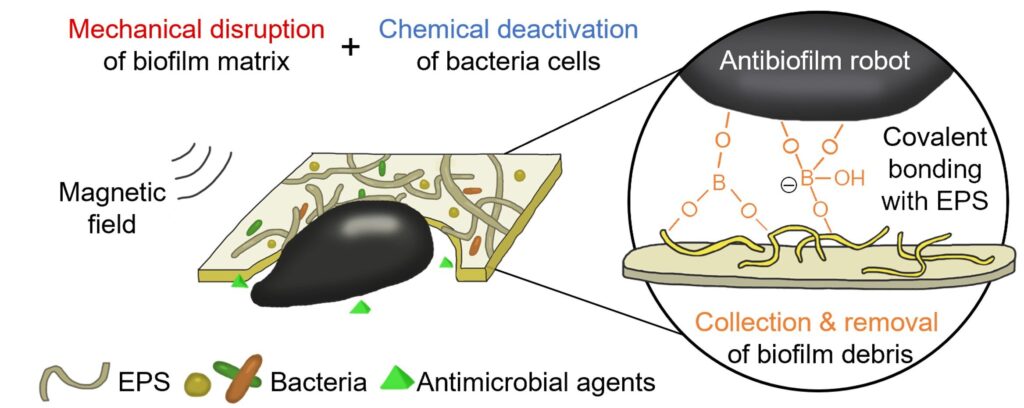An international research team led by the Chinese University of Hong Kong (CUHK) has achieved a breakthrough in the field of medical microrobots by developing the world’s first antibiofilm liquid-bodied magnetic-controlled robot.
They have also introduced new features, including unique viscoelastic properties that allow the robot to adapt to diverse operational environments and a triple synergistic antibiofilm mechanism, paving the way for innovative solutions to combat biofilm infections. The research is published in Science Advances.
The team was led by Professor Zhang Li from the Department of Mechanical and Automation Engineering in CUHK’s Faculty of Engineering—in partnership with Nanyang Technological University (Singapore) and the Max Planck Institute for Intelligent Systems (Germany).
The challenge of biofilm infections
The World Health Organization (WHO) declared antimicrobial resistance (AMR) as one of the top 10 global public health threats facing humanity in 2019, causing nearly 5 million deaths per year globally. AMR is not only related to the emergence of resistant bacterial strains but also significantly due to the formation of biofilm barriers, where bacteria adhere to surfaces and secrete substances.
Medical implants inside the human body that lack immune protection are highly susceptible to biofilm infections. Traditional antibiotic therapy struggles to penetrate biofilm barriers, while surgical removal of infected implants carries risks of secondary trauma.
The team previously developed magnetic microrobots to combat biofilm infections on implants. However, research revealed that while magnetically controlled hydrogel robots could navigate simple tubular structures, they struggled to adapt to complex surfaces such as medical stents and meshes, leaving residual biofilm. In light of these challenges, the team developed the world’s first antibiofilm magnetic-controlled liquid-bodied robot.

Two new features for combating biofilm infections
The newly developed liquid-bodied robot uses a dynamic cross-linked magnetic hydrogel with unique viscoelasticity that aids in eliminating biofilms within the human body. Professor Zhang explained, “By precisely modulating external magnetic fields, the robot can switch between viscoelastic behavioral modes. In elastic mode, it rotates, rolls and overcomes obstacles within the body. In liquid mode, it deforms into a fluid robot to infiltrate crevices and eradicate any biofilm within them.”
The robot also features a triple synergistic antibiofilm mechanism, including physical biofilm disruption, chemical bacteria deactivation and biofilm debris removal. First, magnetic forces transmitted through the robot’s motion mechanically disrupt biofilm structures and weaken their protective effects; then, the antimicrobial agents released by the robot target planktonic bacteria cells; and finally, the robot forms bonds with biofilm fragments, which prevents infections from recurring.
The liquid-bodied robot performed exceptionally in tests on infected medical implants. Biofilm on a 3D-structured hernia mesh was reduced by 84% after treatment, while 87% of bacteria on a metal biliary stent were killed.
Professor Zhang added, “Our team pioneered dual-modality navigation using endoscopy and X-ray imaging, enabling precise control of the robot through metal stents in pig bile ducts. In a mouse model with infected stents, complete weight recovery was observed within 12 days, with a 40% reduction in inflammation indicators compared to the control group. Traditional miniature robots often compromise between accessibility and driving force. This technology achieves both.”
The team is collaborating with Nanyang Technological University’s Lee Kong Chian School of Medicine to develop upgraded antibiofilm robots, with plans to advance to large animal trials and prepare for human clinical studies.
Professor Joseph Sung from Lee Kong Chian School of Medicine, a co-author of the study, commented, “Biliary biofilm infections have long been a focus of my research. When solidified biofilm completely blocks a patient’s bile duct, conventional therapies often fail. This liquid robot offers a novel solution. We aim to integrate next-generation antimicrobial agents and validate its efficacy in clinical settings.”


